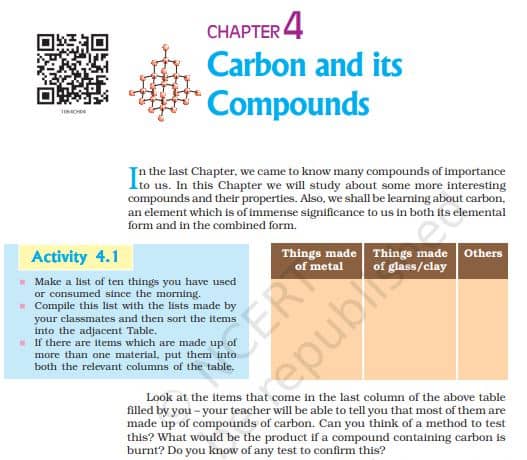‘Carbon And Its Compounds Class 10‘ PDF Quick download link are given at the bottom of this article. You can see the PDF demo, size of the PDF, page numbers, and direct download Free PDF of ‘Carbon And Its Compounds Class 10 Notes’ using the download button.
Carbon And Its Compounds Class 10 Textbook PDF Free Download

BONDING IN CARBON – THE COVALENT BOND
In the previous Chapter, we have studied the properties of ionic compounds. We saw that ionic compounds have high melting and boiling points and conduct electricity in solution or in the molten state.
The shared pair of electrons is said to constitute a single covalent bond between the two hydrogen atoms. A single covalent bond is also represented by a line between the two atoms, as shown in Fig. 4.2.
The atomic number of chlorine is 17. What would be its electronic configuration and its valency? Chlorine forms a diatomic molecule, Cl₂.
Can you draw the electron dot structure for this molecule? Note that only the valence shell electrons need to be depicted.
In the case of oxygen, we see the formation of a double bond between two oxygen atoms.
This is because an atom of oxygen has six electrons in its L shell (the atomic number of oxygen is eight) and it requires two more electrons to complete its octet.
So each atom of oxygen shares two electrons with another atom of oxygen to give us the structure shown in Fig. 4.3.
The two electrons contributed by each oxygen atom give rise to two shared pairs of electrons. This is said to constitute a double bond between the two atoms.
Can you now depict a molecule of water showing the nature of bonding between one oxygen atom and two hydrogen atoms? Does the molecule have single bonds or double bonds?
What would happen in the case of a diatomic molecule of nitrogen? Nitrogen has the atomic number 7.
Allotropes of carbon
The element carbon occurs in different forms in nature with widely varying physical properties.
Both diamond and graphite are formed by carbon atoms, the difference lies in the manner in which the carbon atoms are bonded to one another.
In diamond, each carbon atom is bonded to four other carbon atoms forming a rigid three-dimensional structure.
In graphite, each carbon atom is bonded to three other carbon atoms in the same plane giving a hexagonal array.
One of these bonds is a double-bond, and thus the valency of carbon is satisfied. Graphite structure is formed by the hexagonal arrays being placed in layers one above the other
VERSATILE NATURE OF CARBON
We have seen the formation of covalent bonds by the sharing of electrons in various elements and compounds. We have also seen the structure of a simple carbon compound, methane.
At the beginning of the Chapter, we saw how many things we use contain carbon. In fact, we ourselves are made up of carbon compounds.
The number of carbon compounds whose formulae are known to chemists was recently estimated to be in millions! This outnumbers by a large margin the compounds formed by all the other elements put together.
Why is it that this property is seen in carbon and no other element? The nature of the covalent bond enables carbon to form a large number of compounds. Two factors noticed in the case of carbon are –
(1) Carbon has the unique ability to form bonds with other atoms of carbon, giving rise to large molecules. This property is called catenation.
These compounds may have long chains of carbon, branched chains of carbon, or even carbon atoms arranged in rings. In addition, carbon atoms may be linked by single, double, or triple bonds.
Compounds of carbon, which are linked by only a single between the carbon atoms are called saturated compounds.
Compounds of carbon having double or triple bonds between their carbon atoms are called unsaturated compounds.
No other element exhibits the property of catenation to the extent seen in carbon compounds.
Silicon forms compounds with hydrogen which have chains of up to seven or eight atoms, but these compounds are very reactive. The carbon-carbon bond is very strong
| Author | NCERT |
| Language | English |
| No. of Pages | 21 |
| PDF Size | 2 MB |
| Category | Education |
Related PDFs
500 Women Poses For Photographing PDF With Image
Work Power And Energy Class 9 NCERT PDF
Carbon And Its Compounds Class 10 Textbook PDF Free Download
